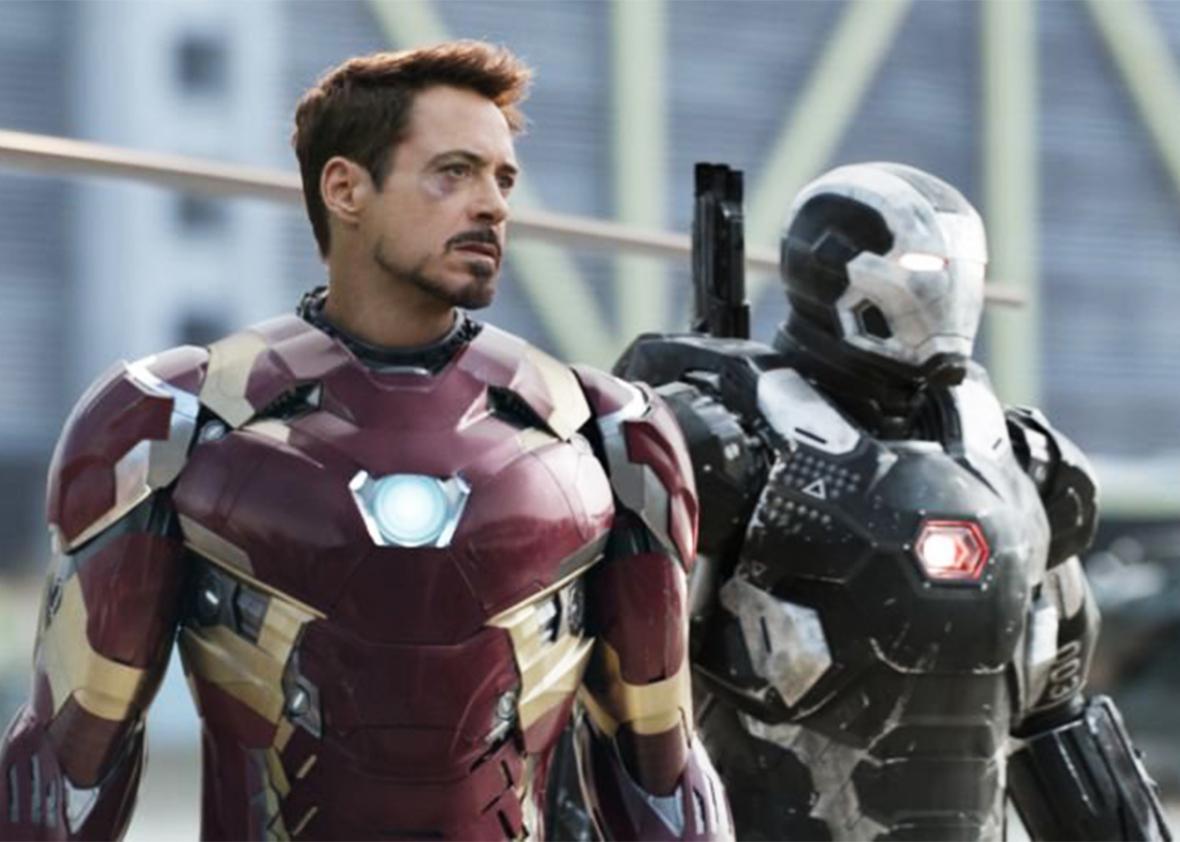In its comic-book form, Marvel’s Civil War was a mess in ways that the new movie deftly avoids. The seven-issue limited series, written by Mark Millar and released in 2006, aimed to situate superheroes in the world of practical politics. A team of young superheroes ambushes a group of villains in Stamford, Connecticut, for their reality show, an act that leads to a violent fight and explosion that kills 600 people, children among them. The public turns against superheroes, and Congress passes a registration act. As Daredevil says to a group of heroes debating the law: “[T]his has been building up for a long time. Stamford’s just the straw that broke the camel’s back.”
Under more capable hands, this could have set the stage for a genuine debate over the ethics of superheroism. Should masked crusaders with incredible powers operate with full autonomy? Are they accountable to the public? What obligations do they hold to the damage they cause and the innocent lives they harm?
Instead, readers were treated to a clumsy metaphor for the war on terror, where Tony Stark’s Iron Man joins the government’s registration push and arrests heroes who don’t comply (sending them to a superhero Guantánamo in the Negative Zone), and Steve Rogers’ Captain America is a civil libertarian leading a noble resistance. Any nuance in the conflict was squashed in favor of a plain-vanilla morality play that misread the core qualities of its central characters. (Somehow, the actual New Dealer in the story, Rogers, is the enemy of the government, while tech-triumphalist Stark is its stooge.)
But that was a decade ago. Before Iron Man, before the Marvel Cinematic Universe, before The Avengers.
Now, Civil War is back—as Captain America: Civil War—and while it owes key themes to its printed predecessor, it’s a different beast entirely.
In the film, there is no registration act—just the “Vienna Accords,” drafted by the United Nations and meant to turn the Avengers into a strike force sanctioned by the U.N. Under the accords, our heroes intervene only when they have permission and stay on the leash when they don’t.
The catalyst isn’t an incident as much as it’s a collection of incidents. The chaos of earlier films in the series—the destruction of Manhattan in The Avengers, of the fictional Sokovia in Age of Ultron, of Washington, D.C., in The Winter Soldier—as well as collateral damage in Civil War’s opening prompt a move to bring the Avengers under some kind of control.
Tony Stark, anxious and grief-stricken after coming face-to-face with the human damage of his superheroism, signs the accords, bringing half the Avenger team with him. Steve Rogers, distrustful of authority and secure in his judgment, refuses. The two disagree, but don’t come to blows.
Things change when authorities go after the Winter Soldier—aka Bucky Barnes, Captain America’s best friend—and a wall falls between Stark and Rogers, as former allies become rivals. This is the titular “civil war,” and it brings in a host of other superheroes, from familiar faces like War Machine, Falcon, Black Widow, the Scarlet Witch, and Ant-Man, to two new characters: Chadwick Boseman’s dutiful, imposing, and magnetic Black Panther, and Tom Holland’s nervous, excitable, adolescent Peter Parker, who are highlights of the film. (Civil War might be the first modern superhero movie with three black leads: Boseman, Don Cheadle as War Machine, and Anthony Mackie as Falcon.)
The conflict between Iron Man and Captain America drives a wedge through this community of heroes. And they fight, in one of the most joyous cinematic superhero battles ever filmed, the closest thing we’ve seen to an on-screen splash page.
What’s important, however, is that this isn’t the conclusion. There’s still more conflict, more pain, and more hurt to go between Captain America, Iron Man, and Bucky. Which gets to what distinguishes Civil War the film from Civil War the comic, and what makes it a unique entry in the Marvel canon overall.
Civil War alludes to the politics of superheroism, but this isn’t a political film. There are tent-pole battles and huge spectacles—the chase between Captain America, Bucky, and Black Panther is an incredible example of deft cinema and showing character through action—but in the end this is a movie about friendships and conflict, and what can happen when the latter overwhelms the former. It’s about two genuine heroes who can’t reconcile their obligations and duties with the friendship they both cherish.
It’s impossible not to compare Civil War to Warner Bros.’ Batman v. Superman: Dawn of Justice. They tackle similar themes—of collateral damage and the role of superheroes’ legitimacy—and they both bring a smorgasbord of characters and mythology to the table. But where Civil War is colorful and fun, Batman v. Superman is dour and dark. Where Civil War showcases the able filmmaking of the Russo brothers, Batman v. Superman reminds us that Zack Snyder is a stylist who can’t tell a story. And most importantly, where Civil War is rooted in character and emotion, Batman v. Superman is an excuse for spectacle. The heroes fight because that’s the movie they’re in, not because it makes sense. They’re not characters as much as they’re pieces on a $250 million board.
That’s where the contrast with Civil War lies, and why Civil War is one of the best films to come out of Marvel Studios. Despite the huge ensemble cast and the expensive special effects, Captain America: Civil War is a human-sized affair. Yes, there’s a villain—Daniel Brühl as Baron Zemo—but he’s almost beside the point. Yes, there’s a final battle, but it isn’t the cataclysm of previous Marvel entries. It’s just two friends, tired and angry, whose mutual hurt and betrayal have brought them to blows.
